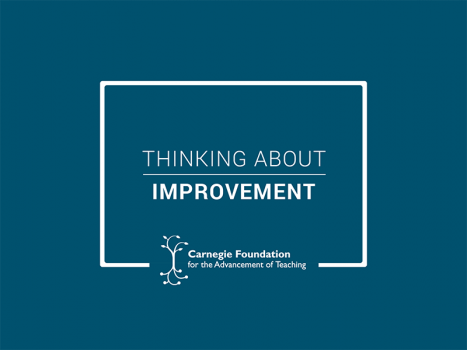The lives of children growing up in poverty in America look dramatically different from the lives of children living in more advantaged settings. Low-income children face persistent inequities in health, language development, and pre-school learning opportunities, and once these children pass through schoolhouse doors, gaps in educational performance and attainment follow.
The substantial educational chasms opened by poverty are sustained by an educational system that fails to reliably serve the students who need it most. Our schools are far from being the “great equalizers” many have touted them to be. This is not news to the education field; we have long been aware of these educational disparities. Why, then, have we failed to make any real difference in closing educational quality gaps for our low-income students?
Researchers Jennifer O’Day with the American Institutes for Research and the Carnegie Foundation’s Marshall (Mike) Smith propose an answer to this question in a recent paper they co-authored, “Quality and Equality in American Education: Systemic Problems, Systemic Solutions,” which includes a substantial discussion of systemic inequality and what we might do to combat it. During a presentation of their findings at the annual Carnegie Foundation Summit on Improvement in Education this past spring, I was especially gripped by the discussion on why we have failed to make substantial steps forward in reducing educational inequity despite decades of reforms.
According to O’Day and Smith, our many attempts over the past 60 years to reduce inequalities in schooling have been hampered by two main factors. The first is our lack of attention to the details of implementation, and the second is our piece-meal approach to change.
Implementation Matters
In prior attempts to make equity-focused reforms, we have made several critical mistakes in implementing new ideas that had the potential to truly benefit students.
- Limited attention to building system capacity. O’Day pointed out that we have consistently asked our education system to tackle new problems without cultivating the necessary capacity to do so. We have required adults in our system to take on changes to practice intended to benefit underserved students, such as bilingual instruction or new math curricula, but have not invested the additional time, resources, or professional development that would allow practitioners to be successful. In addition, the struggling schools into which a great number of interventions are introduced suffer from programmatic incoherence. “One manifestation of this incoherence,” write O’Day and Smith, “… is the accumulation of multiple interventions and programs — some well-intended and researched but all vying for attention and resources.” Despite our consistent lack of investment in building the capacity of educational institutions expected to manage an ever-increasing number of demands, we are repeatedly surprised when our same old system cannot achieve a new and higher purpose.
- Insensitivity to Context. Educational interventions have traditionally been designed as one-size-fits-all solutions, and implementation has rarely taken into account differences in context. In their paper, O’Day and Smith remind us that “varying cultures, conditions, and structures across organizations and systems can influence the ways in which local actors interpret and act on any given intervention.” Schools and districts have differing histories of performance and intervention, and the adults and students within these systems have a variety of prior experiences with schooling and inequity. Without deeply understanding these factors and how they influence implementation, we are left with a long list of good ideas that have failed in practice to perform effectively, reliably, and across local contexts.
- Inattention to social capital. O’Day and Smith argue that reform efforts have traditionally discounted the importance of the relationships between educators and have perpetuated the field’s tendency to practice in isolation, with little sharing between classrooms, schools, and districts. This is especially detrimental in underperforming schools, where high turnover and a lack of trust prevent strong and productive relationships from forming.
Besides a lack of attention to implementation, another primary reason for our lack of progress on educational equity is that change efforts have relied on a piecemeal series of individual reforms. As a field, we tend to look for panaceas for our problems and we expect change to happen fast. When we don’t see the outcomes we want immediately, system leaders feel pressure to move onto the next reform. As an example, O’Day and Smith cite the response from districts to slow the revolving door of teachers in high-poverty schools. Many have introduced financial incentives, but are not paying attention to other systemic factors that cause teachers to leave, such as poor working conditions, lack of input, and unsupportive administrators.
We can design a system that is more coherent, efficient, and effective in serving all students.
Potential of Networked Improvement
As an improvement specialist, I have spent a great deal of time considering how improvement science practiced in networks could allow us to make long-overdue progress on reducing inequity. I was struck by how O’Day and Smith described these obstacles to systemic reform, and here I propose three ideas on how a networked improvement approach might help us to surmount them.
Learn what works
First, in any improvement science approach to change, implementation is a key focus. After all, the goal of improvement science is to learn what works, for whom and under what set of conditions. Learning that something works is important, but learning how to get it to work reliably is just as critical. Carnegie’s Six Core Principles of Improvement remind us of this. When we attend to variation in performance and make our work problem-specific and user-centered, we gain great insight into the contextual factors that are key to successful implementation of promising practices.
The principles help us avoid the danger of failing to deeply understand the organizational contexts in which we hope good ideas will take root. O’Day and Smith see great potential for a shift to increased focus on implementation as we move from the performance-based accountability system built under No Child Left Behind to the emphasis on local and state responsibility for improvement outlined in the Every Student Succeeds Act. As O’Day and Smith see it, the proper policy environment will empower us to build a system that approaches improvement with an appreciation for differences in local context.
See the System
Second, fundamental to improvement science is the belief that systems achieve exactly the results they are designed to produce. Seeing the system requires that we attend to programmatic coherence and the interconnections between initiatives. Through this lens, we can strategically address the root causes of inequity instead of layering piecemeal and superficial intervention programs atop a system that is already producing sub-optimal results for students.
O’Day and Smith see a more equitable education system as one that focuses interventions on key leverage points for equity, such as 3rd grade literacy or the transition from middle to high school. By considering not only promising individual initiatives but also how they work together to target the root causes of inequity, we can design a system that is more coherent, efficient, and effective in serving all students.
Identify Common Aims
Third, organizing improvement work in networks allows us to better attend to the social nature of change. By coming together in networks, educators directly challenge long-standing professional norms of individual autonomy and isolation, and instead collaborate to identify problems, and then, together, design solutions for the benefit of the larger community.
More equity-minded reformers should consider the benefits of a networked improvement science approach to change. The tools and underlying values of improvement science are well suited to address some of the largest roadblocks to meaningful reforms that promote equity. When we bring these powerful ideas together within networks of dedicated, equity-focused educators, there is tremendous potential for systemic change on behalf of those who need it most. Perhaps our generation of reformers can accomplish what previous generations have struggled to do: finally close the gaps that too often separate our low-income students from the exceptional educational experiences and outcomes they deserve.
October 31, 2016
What will it take to make effective, lasting, and scalable education improvements? It’s not a silver bullet. Policymakers and practitioners must start working together to design solutions based on research and evidence.
November 14, 2016
Policy can do a lot to support positive changes, but policy alone isn’t effective in such large, diverse, and complex arenas as education, wrote policy analyst Paul Lingenfelter in comments solicited by the federal Commission on Evidence-Based Policymaking.






